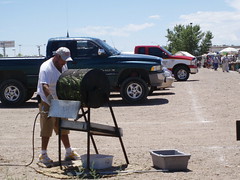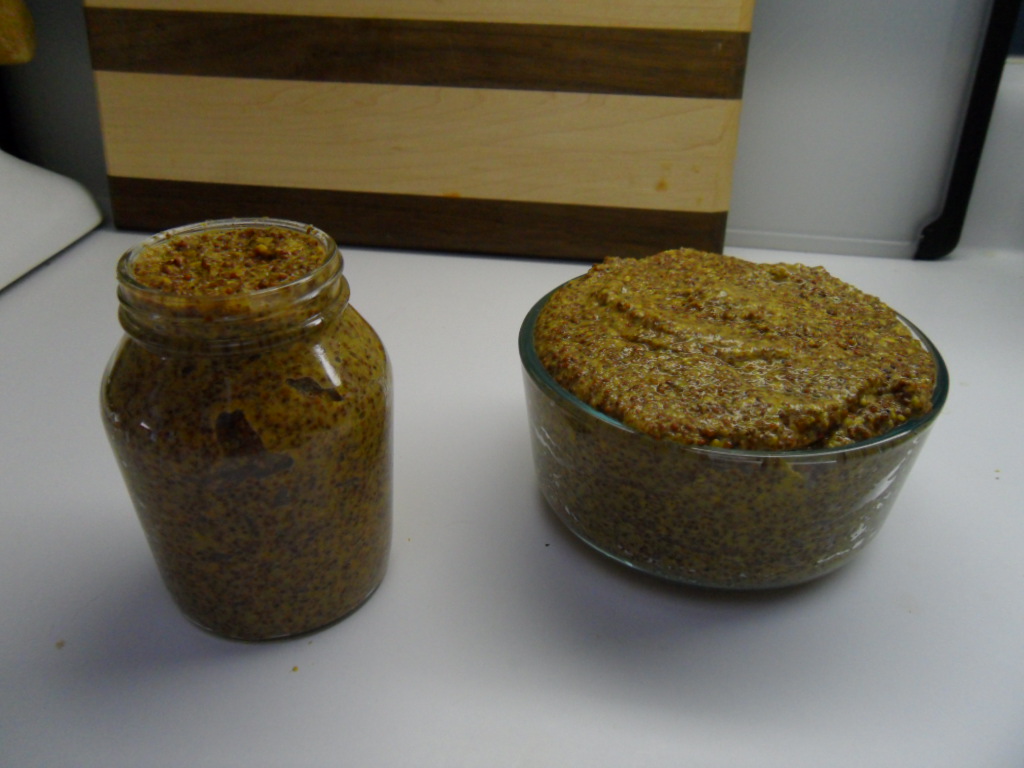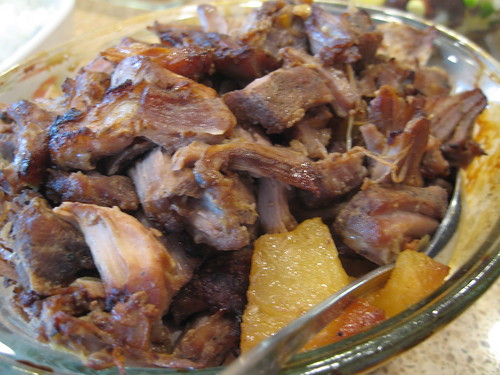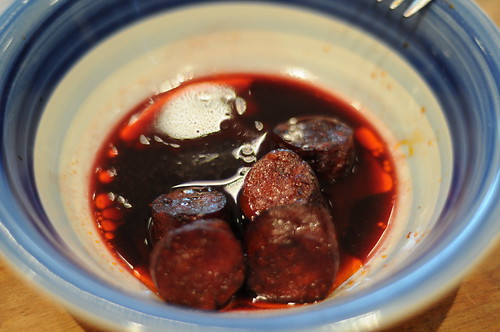 brianS asked if I would help him out with a vegan green chili stew. I don't mind helping a brother out, but a vegan green chili stew is tantamount to sacrilege. I'll do my best, doc. First a little bit of background on one of New Mexico's finest culinary offerings: Hatch Green Chili. Green chilies are grown all over the world, heck even some green chilies grown in China are being sold as Hatch (boo on them), but the chilies grown in Hatch, NM are the best in the world. Cultivated for heat and appearance by the agriculture department at New Mexico State University these chilies are more science than nature, but boy are they delicious. For those of you up north you'll find little cans of diced, chopped, or whole chilies under the hatch label in grocery stores, but they pale in comparison to the real goods. Anaheim peppers work as a substitute, but tend to be a bit sweeter and less spicy than their Hatch / NM cousins.
brianS asked if I would help him out with a vegan green chili stew. I don't mind helping a brother out, but a vegan green chili stew is tantamount to sacrilege. I'll do my best, doc. First a little bit of background on one of New Mexico's finest culinary offerings: Hatch Green Chili. Green chilies are grown all over the world, heck even some green chilies grown in China are being sold as Hatch (boo on them), but the chilies grown in Hatch, NM are the best in the world. Cultivated for heat and appearance by the agriculture department at New Mexico State University these chilies are more science than nature, but boy are they delicious. For those of you up north you'll find little cans of diced, chopped, or whole chilies under the hatch label in grocery stores, but they pale in comparison to the real goods. Anaheim peppers work as a substitute, but tend to be a bit sweeter and less spicy than their Hatch / NM cousins.
To prep green chili for almost any application you'll need to flame roast them. I've done this several ways, but the traditional path is to roast them over a charcoal grill which imparts a delicious smokey flavor. Totally blacken the skin on all sides over a high heat from your gas burner or over a gas or charcoal grill, and throw the peppers into a plastic bag to let them steam their skins off. Once the peppers have cooled a bit shuck the skins and remove that veins and seeds from the pods. At this point you can do almost anything with them, such as stuff the peppers with queso, bread em (blue corn tortilla crust..../drool), and fry them up relleno style, or you can simply chop the peppers up and serve them naked over eggs, on top of burgers, or add them to your stew.
Green Chili Stew, done the meat and cheese way, you'll need:
Traditional green chili usually has pork as the protein base, but I've switched to chicken for a leaner meaner soup, and tomatoes - I feel that the acid level goes off the charts with tomatoes added, but it's your world.
a package of chicken legs, skin removed if you want to be healthy
12 Oz of chilies, cans will be mild (read: not a lick of spice) I usually incorporate a can of mild with 8 oz of the hot stuff - (every year they roast by the bushel, and I buy a whole which will last me about a year)
Potatoes - any kind will do, but the yellow ones cook so much nicer in liquid than a russet - the more the merrier
a medium onion
3 cloves of garlic
cumin, red chili powder, salt and pepper to taste
Corn Tortillas
cheddar cheese
64 ish oz of water, chicken stock, or a combination of both
Method:
Place the chicken legs in a large stock pot and cover with water, chicken stock, or a combo of both and crank up the heat to high. When I'm feeling like I want a really rich soup I use all stock as the cooking liquid, but you're essentially making stock by boiling the legs anyway so this is up to your taste preference. After the legs are cooked through, about 30 minutes, remove them to a bowl and put them in the fridge. Meanwhile, you've chopped up the onion, garlic, and potato into your favorite size and shape, and now it's time to add them to the stock with a hit of salt, pepper, cumin (more is better in my opinion), red chili (gives the final soup some real earthy notes, good for rounding out flavor) and the green chilies. Bring the liquid back up to a boil, cover and simmer until the potatoes are fork tender. Test the broth at this point, adjust seasoning as you see fit. While you're waiting for the potatoes to cook preheat your oven to 350. Spray both sides of the corn tortillas with cooking spray, salt the top side lightly, and bake on a tray, flipping once, until golden brown - about 15 minutes give or take. When the potatoes are done, remove the chicken from the fridge and shred off the bone. Your fingers will thank me for telling you to put the chicken in the fridge. Return the pot to a slow boil, and smash a few of the potatoes against the side of the pot. The starch you release will help thicken the broth.
Serve in deep bowls with a spoonful of sour cream, some shredded cheddar cheese, and tortillas crushed over the top. Nothing better in the winter.
Vegan version (Doc, I love you man...)
12 oz green chili
64 oz Veggie Stock
1 can of corn, or fire roasted corn off the cob ... or better yet hominy (This addition is great with the above recipe, btw)
a medium onion
3 cloves of garlic
cumin, red chili powder, salt and pepper to taste
Corn tortilla
The method remains largely the same here. I would suggest oven roasting the corn or hominy to caramelize some of the sugars to release the natural sweetness. Take half the caramelized corn or hominy and puree it until smooth, adding the remaining whole kernels just before serving.
That's what I've got, doc. You can do something similar with squash, and I'd probably reach for a tomato in this instance.




